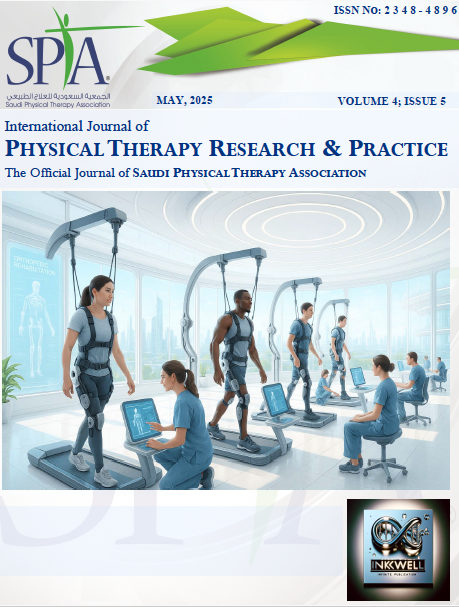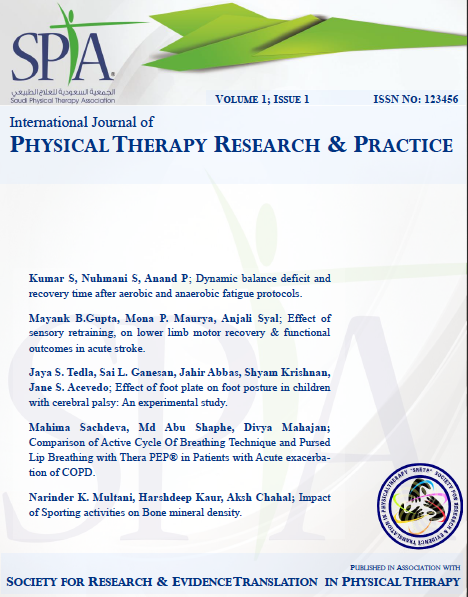The Relationship Between Perceived Stress Levels and Low Back Pain in Physical Therapy Students at Jazan University
DOI:
https://doi.org/10.62464/ijoprp.v4i5.100Keywords:
Stress, LBP, Students, Physical Therapy, LifestyleAbstract
Background: Low back pain (LBP) is a prevalent musculoskeletal issue among university students, particularly those in physically demanding programs such as physical therapy. Psychological stress, a common experience among students, has been identified as a potential risk factor for musculoskeletal pain. However, the association between perceived psychological stress and LBP in physical therapy students remains underexplored. Objective: This study aimed to determine the relationship between perceived stress levels and low back pain in physical therapy students at Jazan University. Methods: This cross-sectional study was conducted among physical therapy students at Jazan University between October and November 2024. Participants aged 18–30 years were surveyed using a structured questionnaire, which included the Perceived Stress Scale (PSS-10) to assess psychological stress and a standard LBP screening questionnaire. Sociodemographic variables and health-related behaviors were also collected. Descriptive statistics and Chi-square tests were used to analyze the data. Results: Out of 170 participants, 88% reported experiencing LBP. The majority of students (47.06%) exhibited moderate stress levels, and 28.24 % reported high stress levels. A statistically significant association was found between higher perceived stress levels and the presence of LBP (p < 0.05). Female students reported a higher prevalence of both stress and LBP compared to male students. Conclusion: This study highlights a significant relationship between psychological stress and low back pain among physical therapy students. These findings underscore the importance of implementing stress management and ergonomic education programs within academic settings to reduce the risk of musculoskeletal disorders.
References
Al-Sowygh, Z. H. (2013). Academic distress, perceived stress and coping strategies among dental students in Saudi Arabia. The Saudi Dental Journal, 25(3), 97–105. https://doi.org/10.1016/j.sdentj.2013.05.002
Andersen, L. L., Fallentin, N., & Sjøgaard, G. (2020). Academic stress and musculoskeletal pain in students: A systematic review. Scandinavian Journal of Work, Environment & Health, 46(5), 501–510. https://doi.org/10.5271/sjweh.3910
Balagué, F., Mannion, A. F., Pellisé, F., & Cedraschi, C. (2012). Non-specific low back pain. The Lancet, 379(9814), 482–491. https://doi.org/10.1016/S0140-6736(11)60610-7
Bishop, M. D., George, S. Z., Robinson, M. E., & Robinson, S. S. (2015). Pain catastrophizing mediates the relationship between pain intensity and disability in patients with musculoskeletal pain. Annals of Behavioral Medicine, 49(4), 474–481. https://doi.org/10.1007/s12160-014-9674-1
Cohen, S., Janicki-Deverts, D., & Miller, G. E. (2007). Psychological stress and disease. JAMA, 298(14), 1685–1687. https://doi.org/10.1001/jama.298.14.1685
Dugan, S. A., Bromberger, J. T., Segawa, E., Avery, E., & Sternfeld, B. (2018). Association between physical activity and depressive symptoms: Midlife women in SWAN. Medicine and Science in Sports and Exercise, 50(2), 335–343. https://doi.org/10.1249/MSS.0000000000001425
Foster, C., Hillsdon, M., Thorogood, M., Kaur, A., & Wedatilake, T. (2021). Interventions for promoting physical activity. Cochrane Database of Systematic Reviews, 2021(12). https://doi.org/10.1002/14651858.CD003180.pub4
González, E. M., Cebrià i Iranzo, M. À., & Carles i Sauras, S. (2020). Prevalence and risk factors of low back pain among university students. Journal of Back and Musculoskeletal Rehabilitation, 33(6), 933–940. https://doi.org/10.3233/BMR-181298
Graves, J. M., Mack, C. D., Helmkamp, J. C., Nagle, J. L., & Coben, J. H. (2019). Ergonomic risk factors and low back pain in university settings. Occupational Medicine, 69(1), 12–18. https://doi.org/10.1093/occmed/kqy128
Hoy, D., Bain, C., Williams, G., March, L., Brooks, P., Blyth, F., ... & Buchbinder, R. (2012). A systematic review of the global prevalence of low back pain. Arthritis & Rheumatism, 64(6), 2028–2037. https://doi.org/10.1002/art.34347
Kadam, P., Chavan, S., & Bhatnagar, S. (2021). Association between perceived stress and low back pain among college students: A cross-sectional study. International Journal of Physiotherapy and Research, 9(1), 3707–3712. https://doi.org/10.16965/ijpr.2021.100
Kumar, S., Singh, M., & Verma, A. (2019). The role of psychological stress in musculoskeletal disorders: An overview. Indian Journal of Occupational and Environmental Medicine, 23(3), 104–108. https://doi.org/10.4103/ijoem.IJOEM_156_18
Linton, S. J. (2000). A review of psychological risk factors in back and neck pain. Spine, 25(9), 1148–1156. https://doi.org/10.1097/00007632-200005010-00017
McEwen, B. S. (2008). Central effects of stress hormones in health and disease: Understanding the protective and damaging effects of stress and stress mediators. European Journal of Pharmacology, 583(2-3), 174–185. https://doi.org/10.1016/j.ejphar.2007.11.071
Olsson, M., Nilsson, M. H., & Bergquist, R. (2020). Obesity and low back pain: The role of inflammation. Current Obesity Reports, 9(1), 1–7. https://doi.org/10.1007/s13679-020-00364-0
Saleh, D., Camart, N., & Romo, L. (2017). Predictors of stress in college students. Frontiers in Psychology, 8, 19. https://doi.org/10.3389/fpsyg.2017.00019
Santos, G. B., Fernandes, M. P., Nogueira, J. A. D., & Moreira, R. P. (2022). Sedentary behavior and back pain among college students: A cross-sectional study. Revista Brasileira de Medicina do Esporte, 28(1), 22–26. https://doi.org/10.1590/1517-8692202228012021_0082
Smith, D. R., Leggat, P. A., & Clark, M. J. (2020). Musculoskeletal disorders among health care students. International Journal of Nursing Practice, 26(4), e12829. https://doi.org/10.1111/ijn.12829
van Tulder, M. W., Koes, B. W., & Bouter, L. M. (2006). A cost-of-illness study of back pain in The Netherlands. Pain, 62(2), 233–240. https://doi.org/10.1016/S0304-3959(96)03347-5
Wang, X., Zheng, J., Zhang, Y., & Wang, J. (2021). Prevalence and risk factors of low back pain among college students in China. Healthcare, 9(7), 832. https://doi.org/10.3390/healthcare9070832.

Downloads
Published
Issue
Section
License
Copyright (c) 2025 International Journal of Physical Therapy Research & Practice

This work is licensed under a Creative Commons Attribution-NonCommercial-NoDerivatives 4.0 International License.



